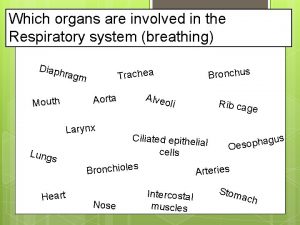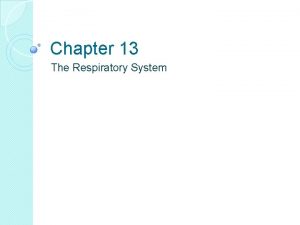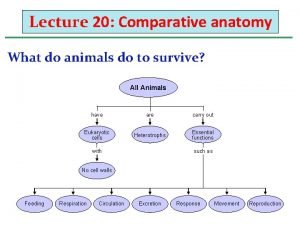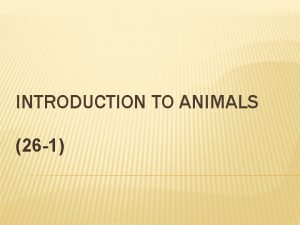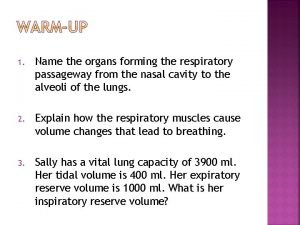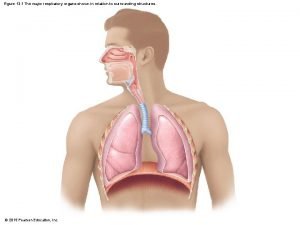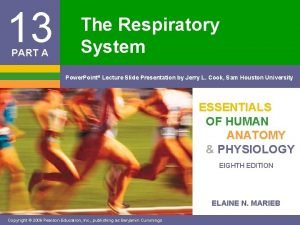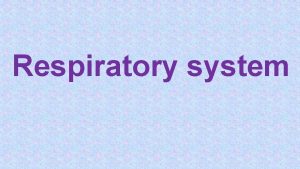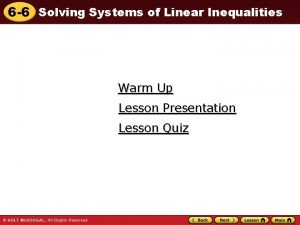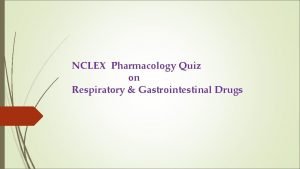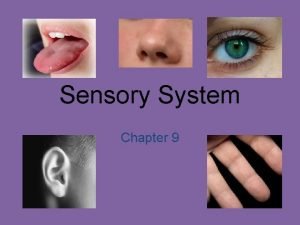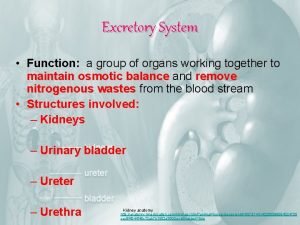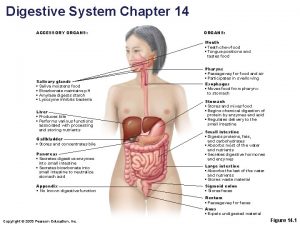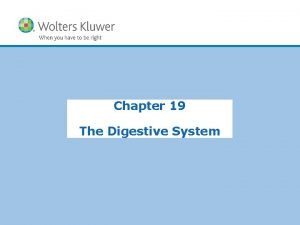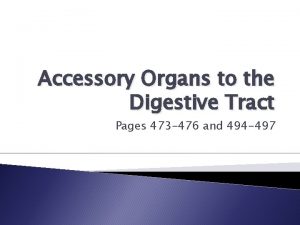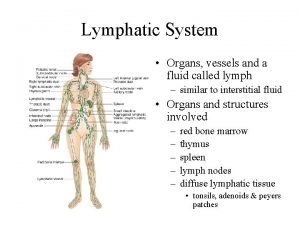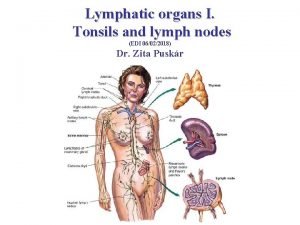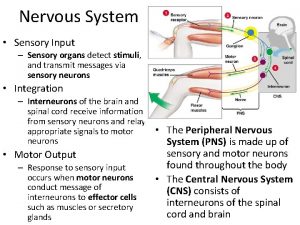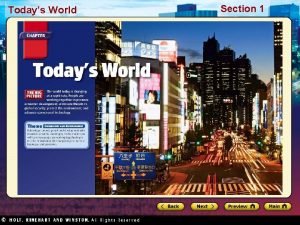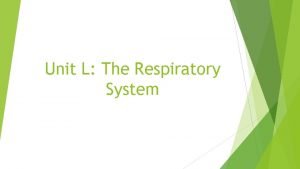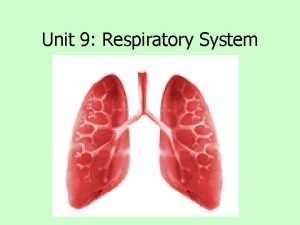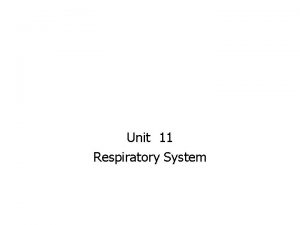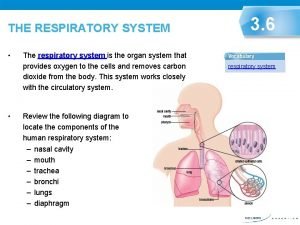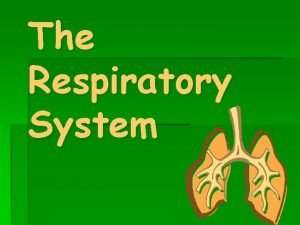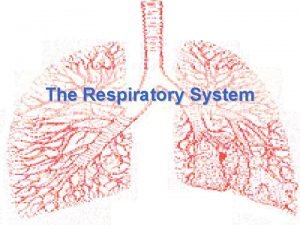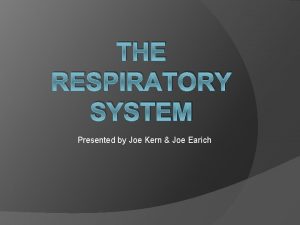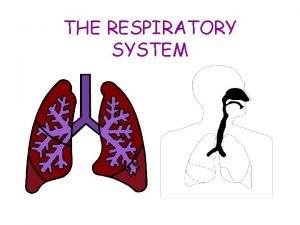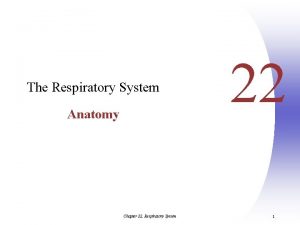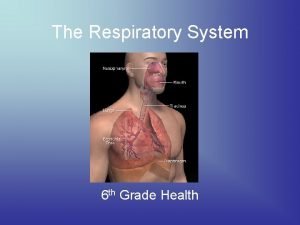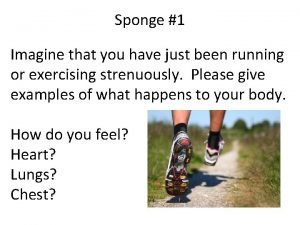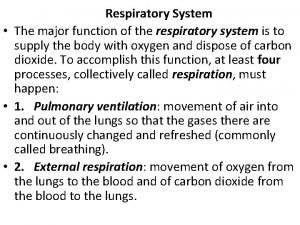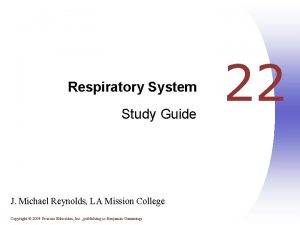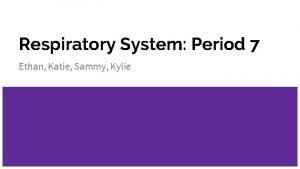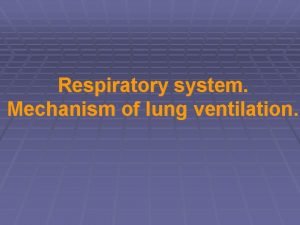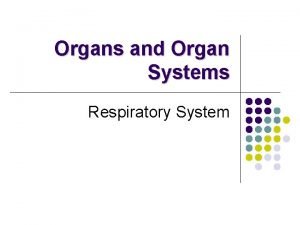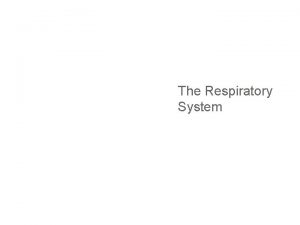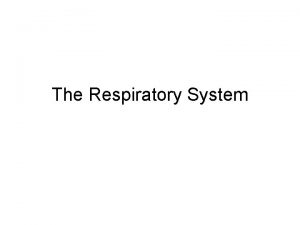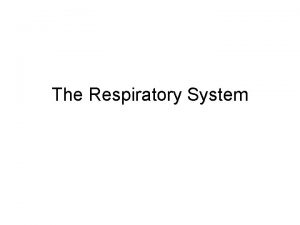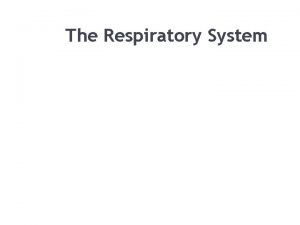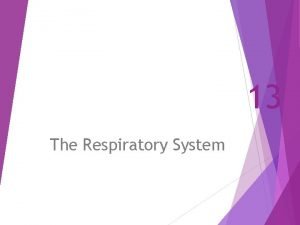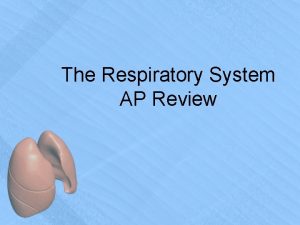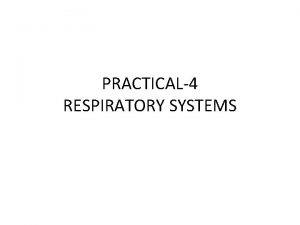Today Quiz Respiratory system part 1 Organs of























































- Slides: 55

Today • Quiz • Respiratory system part 1

Organs of the Respiratory System • Nose • Pharynx • Larynx • Trachea • Bronchi • Lungs—alveoli

Nasal cavity Nostril Oral cavity Pharynx Larynx Trachea Right main (primary) bronchus Left lung Right lung Diaphragm

Functions of the Respiratory System • Gas exchanges between the blood and external environment • Occur in the alveoli of the lungs • Passageways to the lungs purify, humidify, and warm the incoming air

The Nose • The only externally visible part of the respiratory system • Air enters the nose through the external nostrils (nares) • Interior of the nose consists of a nasal cavity divided by a nasal septum Remember that if any area is open to the outside (even if it’s inside), it is lined with mucous membranes (wet/moist membranes)

Cribriform plate of ethmoid bone Sphenoidal sinus Posterior nasal aperture Nasopharynx • Pharyngeal tonsil • Opening of pharyngotympanic tube • Uvula Oropharynx • Palatine tonsil • Lingual tonsil Laryngopharynx Esophagus Trachea Frontal sinus Nasal cavity • Nasal conchae (superior, middle and inferior) • Nasal meatuses (superior, middle, and inferior) • Nasal vestibule • Nostril Hard palate Soft palate Tongue Hyoid bone Larynx • Epiglottis • Thyroid cartilage • Vocal fold • Cricoid cartilage (b) Detailed anatomy of the upper respiratory tract

The Nose • Olfactory receptors are located in the mucosa on the superior surface • The rest of the cavity is lined with respiratory mucosa, which: • Moistens air • Traps incoming foreign particles

The Nose • Lateral walls have projections called conchae • Increase surface area • Increase air turbulence within the nasal cavity • The nasal cavity is separated from the oral cavity by the palate • Anterior hard palate (bone) • Posterior soft palate (unsupported)

Paranasal Sinuses • Cavities within bones surrounding the nasal cavity are called sinuses • Sinuses are located in the following bones: • • Frontal Sphenoid Ethmoid Maxillary

Cribriform plate of ethmoid bone Sphenoidal sinus Posterior nasal aperture Nasopharynx • Pharyngeal tonsil • Opening of pharyngotympanic tube • Uvula Oropharynx • Palatine tonsil • Lingual tonsil Laryngopharynx Esophagus Trachea Frontal sinus Nasal cavity • Nasal conchae (superior, middle and inferior) • Nasal meatuses (superior, middle, and inferior) • Nasal vestibule • Nostril Hard palate Soft palate Tongue Hyoid bone Larynx • Epiglottis • Thyroid cartilage • Vocal fold • Cricoid cartilage

Paranasal Sinuses • Functions of the sinuses: • Lighten the skull • Act as resonance chambers for speech • Produce mucus that drains into the nasal cavity

Pharynx (Throat) • Muscular passage from nasal cavity to larynx • Three regions of the pharynx: 1. Nasopharynx—superior region behind nasal cavity 2. Oropharynx—middle region behind mouth 3. Laryngopharynx—inferior region attached to larynx • The oropharynx and laryngopharynx are common passageways for air and food

Pharynx • Nasopharynx • Oropharynx • Laryngopharynx (a) Regions of the pharynx

Pharynx (Throat) • Pharyngotympanic tubes open into the nasopharynx • Tonsils of the pharynx • Pharyngeal tonsil (adenoid) is located in the nasopharynx • Palatine tonsils are located in the oropharynx • Lingual tonsils are found at the base of the tongue

Cribriform plate of ethmoid bone Sphenoidal sinus Posterior nasal aperture Nasopharynx • Pharyngeal tonsil • Opening of pharyngotympanic tube • Uvula Oropharynx • Palatine tonsil • Lingual tonsil Laryngopharynx Esophagus Trachea Frontal sinus Nasal cavity • Nasal conchae (superior, middle and inferior) • Nasal meatuses (superior, middle, and inferior) • Nasal vestibule • Nostril Hard palate Soft palate Tongue Hyoid bone Larynx • Epiglottis • Thyroid cartilage • Vocal fold • Cricoid cartilage (b) Detailed anatomy of the upper respiratory tract

Larynx (Voice Box) • Routes air and food into proper channels • Plays a role in speech • Made of eight rigid hyaline cartilages and a spoon-shaped flap of elastic cartilage (epiglottis) https: //www. youtube. com/watch? v=Lqd. FL 0 u 2 HLY https: //www. youtube. com/watch? v=C 7 Cpk. Eszks. I https: //www. youtube. com/watch? v=Tsh-0 Vv. AGQA

Larynx (Voice Box) • Thyroid cartilage • Largest of the hyaline cartilages • Protrudes anteriorly (Adam’s apple) • Epiglottis • Protects the superior opening of the larynx • Routes food to the posteriorly situated esophagus and routes air toward the trachea • When swallowing, the epiglottis rises and forms a lid over the opening of the larynx

Larynx (Voice Box) • Vocal folds (true vocal cords) • Vibrate with expelled air • The glottis consists of the vocal cords and the slitlike pathway (opening)

Figure 13. 2 b Basic anatomy of the upper respiratory tract, sagittal section. Cribriform plate of ethmoid bone Sphenoidal sinus Posterior nasal aperture Nasopharynx • Pharyngeal tonsil • Opening of pharyngotympanic tube • Uvula Oropharynx • Palatine tonsil • Lingual tonsil Laryngopharynx Esophagus Trachea Frontal sinus Nasal cavity • Nasal conchae (superior, middle and inferior) • Nasal meatuses (superior, middle, and inferior) • Nasal vestibule • Nostril Hard palate Soft palate Tongue Hyoid bone Larynx • Epiglottis • Thyroid cartilage • Vocal fold • Cricoid cartilage (b) Detailed anatomy of the upper respiratory tract

Trachea (Windpipe) • 4 -inch-long tube that connects larynx with bronchi • Walls are reinforced with C-shaped hyaline cartilage, which keeps the trachea open (patent) • Lined with ciliated mucosa • Cilia beat continuously in the opposite direction of incoming air • Expel mucus loaded with dust and other debris away from lungs

Figure 13. 3 a Structural relationship of the trachea and esophagus. Posterior Mucosa Submucosa Esophagus Trachealis muscle Lumen of trachea Seromucous gland in submucosa Hyaline cartilage Adventitia (a) Anterior

Figure 13. 3 b Structural relationship of the trachea and esophagus. (b)

Main (Primary) Bronchi • Formed by division of the trachea • Each bronchus enters the lung at the hilum (medial depression) • Right bronchus is wider, shorter, and straighter than left • Bronchi subdivide into smaller and smaller branches

Figure 13. 1 The major respiratory organs shown in relation to surrounding structures. Nasal cavity Nostril Oral cavity Pharynx Larynx Trachea Right main (primary) bronchus Left lung Right lung Diaphragm

Lungs • Occupy most of the thoracic cavity • Heart occupies central portion called mediastinum • Apex is near the clavicle (superior portion) • Base rests on the diaphragm (inferior portion) • Each lung is divided into lobes by fissures • Left lung—two lobes • Right lung—three lobes

Coverings of the Lungs • Serosa covers the outer surface of the lungs • Pulmonary (visceral) pleura covers the lung surface • Parietal pleura lines the walls of the thoracic cavity • Pleural fluid fills the area between layers to allow gliding and decrease friction during breathing • Pleural space (between the layers) is more of a potential space

Figure 13. 4 a Anatomical relationships of organs in the thoracic cavity. Intercostal muscle Rib Trachea Parietal pleura Pleural cavity Visceral pleura Lung Thymus Apex of lung Right superior lobe Horizontal fissure Right middle lobe Oblique fissure Right inferior lobe Heart (in pericardial cavity of mediastinum) Diaphragm Base of lung Left superior lobe Oblique fissure Left inferior lobe (a) Anterior view. The lungs flank mediastinal structures laterally.

Figure 13. 4 b Anatomical relationships of organs in the thoracic cavity. Vertebra Posterior Esophagus (in posterior mediastinum) Root of lung at hilum • Left main bronchus • Left pulmonary artery • Left pulmonary vein Right lung Parietal pleura Visceral pleura Left lung Pleural cavity Thoracic wall Pulmonary trunk Pericardial membranes Sternum Heart (in mediastinum) Anterior mediastinum Anterior (b) Transverse section through the thorax, viewed from above.

Bronchial (Respiratory) Tree Divisions • All but the smallest of these passageways have reinforcing cartilage in their walls • Conduits to and from the respiratory zone • • • Primary bronchi Secondary bronchi Tertiary bronchi Bronchioles Terminal bronchioles

Respiratory Zone Structures • Respiratory bronchioles • Alveolar ducts • Alveolar sacs • Alveoli (air sacs)

Figure 13. 5 a Respiratory zone structures. Alveolar duct Respiratory bronchioles Terminal bronchiole (a) Diagrammatic view of respiratory bronchioles, alveolar ducts, and alveoli Alveolar duct Alveolar sac

Figure 13. 5 b Respiratory zone structures. Alveolar duct Alveolus (b) Light micrograph of human lung tissue, showing the final divisions of the respiratory tree (120×) Alveolar pores

The Respiratory Membrane • Thin squamous epithelial layer lines alveolar walls • Alveolar pores connect neighboring air sacs • Pulmonary capillaries cover external surfaces of alveoli • Respiratory membrane (air-blood barrier) • On one side of the membrane is air, and on the other side is blood flowing past • Formed by alveolar and capillary walls

The Respiratory Membrane • Gas crosses the respiratory membrane by diffusion • Oxygen enters the blood • Carbon dioxide enters the alveoli • Alveolar macrophages (“dust cells”) add protection by picking up bacteria, carbon particles, and other debris • Surfactant (a lipid molecule) coats gas-exposed alveolar surfaces

Figure 13. 6 Anatomy of the respiratory membrane (air-blood barrier). Red blood cell Capillary Endothelial cell nucleus Alveolar pores Capillary Macrophage Nucleus of squamous epithelial cell Respiratory membrane Alveoli (gasfilled air spaces) Squamous Red blood Surfactantcell in secreting cell epithelial cell of alveolar wall capillary O 2 CO 2 Alveolus Alveolar epithelium Fused basement membranes Capillary endothelium

Four Events of Respiration 1. Pulmonary ventilation—moving air into and out of the lungs (commonly called breathing) 2. External respiration—gas exchange between pulmonary blood and alveoli • Oxygen is loaded into the blood • Carbon dioxide is unloaded from the blood

Four Events of Respiration 3. Respiratory gas transport—transport of oxygen and carbon dioxide via the bloodstream 4. Internal respiration—gas exchange between blood and tissue cells in systemic capillaries

Mechanics of Breathing (Pulmonary Ventilation) • Completely mechanical process that depends on volume changes in the thoracic cavity • Volume changes lead to pressure changes, which lead to the flow of gases to equalize pressure

Mechanics of Breathing (Pulmonary Ventilation) • Two phases • Inspiration = inhalation • Flow of air into lungs • Expiration = exhalation • Air leaving lungs

Mechanics of Breathing (Pulmonary Ventilation) • Inspiration • Diaphragm and external intercostal muscles contract • The size of the thoracic cavity increases • External air is pulled into the lungs as a result of: • Increase in intrapulmonary volume • Decrease in gas pressure • Air is sucked into the lungs

Figure 13. 7 a Rib cage and diaphragm positions during breathing. Changes in anterior-posterior and superior-inferior dimensions Ribs elevated as external intercostals contract External intercostal muscles Changes in lateral dimensions Full inspiration (External intercostals contract) Diaphragm moves inferiorly during contraction (a) Inspiration: Air (gases) flows into the lungs

Pressure relative to atmospheric pressure Figure 13. 8 Changes in intrapulmonary pressure and air flow during inspiration and expiration. +2 +1 Inspiration Expiration Intrapulmonary pressure 0 − 1 − 2 (a) Volume of breath Volume (L) 0. 5 0 − 0. 5 (b)

Mechanics of Breathing (Pulmonary Ventilation) • Expiration • Largely a passive process that depends on natural lung elasticity • As muscles relax, air is pushed out of the lungs as a result of: • Decrease in intrapulmonary volume • Increase in gas pressure • Forced expiration can occur mostly by contraction of internal intercostal muscles to depress the rib cage


Mechanics of Breathing (Pulmonary Ventilation) • Normal pressure within the pleural space is always negative (intrapleural pressure) • Differences in lung and pleural space pressures keep lungs from collapsing • Atelectasis is collapsed lung • Pneumothorax is the presence of air in the intrapleural space

Figure 13. 7 b Rib cage and diaphragm positions during breathing. Changes in anterior-posterior and superior-inferior dimensions Changes in lateral dimensions Ribs depressed as external intercostals relax External intercostal muscles Diaphragm moves superiorly as it relaxes (b) Expiration: Air (gases) flows out of the lungs Expiration (External intercostals relax)

Pressure relative to atmospheric pressure +2 +1 Inspiration Expiration Intrapulmonary pressure 0 − 1 − 2 (a) Volume of breath Volume (L) 0. 5 0 − 0. 5 (b)

Respiratory Volumes and Capacities • Normal breathing moves about 500 ml of air with each breath • This respiratory volume is tidal volume (TV) • Many factors affect respiratory capacity • • A person’s size Sex Age Physical condition

Respiratory Volumes and Capacities • Inspiratory reserve volume (IRV) • Amount of air that can be taken in forcibly over the tidal volume • Usually around 3, 100 ml • Expiratory reserve volume (ERV) • Amount of air that can be forcibly exhaled after a tidal expiration • Approximately 1, 200 ml

Respiratory Volumes and Capacities • Residual volume • Air remaining in lung after expiration • Allows gas exchange to go on continuously, even between breaths, and helps keep alveoli open (inflated) • About 1, 200 ml

Respiratory Volumes and Capacities • Vital capacity • The total amount of exchangeable air • Vital capacity = TV + IRV + ERV • 4, 800 ml in men; 3, 100 ml in women • Dead space volume • Air that remains in conducting zone and never reaches alveoli • About 150 ml

Respiratory Volumes and Capacities • Functional volume • Air that actually reaches the respiratory zone • Usually about 350 ml • Respiratory capacities are measured with a spirometer

6, 000 Milliliters (ml) 5, 000 4, 000 3, 000 2, 000 1, 000 0 Inspiratory reserve volume 3, 100 ml Tidal volume 500 ml Expiratory reserve volume 1, 200 ml Residual volume 1, 200 ml Vital capacity 4, 800 ml Total lung capacity 6, 000 ml

Nonrespiratory Air (Gas) Movements • Can be caused by reflexes or voluntary actions • Examples: • • • Cough and sneeze—clears lungs of debris Crying—emotionally induced mechanism Laughing—similar to crying Hiccup—sudden inspirations Yawn—very deep inspiration https: //www. youtube. com/watch? v=h 53 Q 0 tsl. R 9 Y

 Which organs are involved in respiratory system
Which organs are involved in respiratory system Chapter 13 the respiratory system
Chapter 13 the respiratory system Respiratory zone and conducting zone
Respiratory zone and conducting zone Invertebrate respiratory system
Invertebrate respiratory system Germ layers
Germ layers Organs forming the respiratory passageway
Organs forming the respiratory passageway Parts of the upper respiratory tract
Parts of the upper respiratory tract Figure 13-1
Figure 13-1 Digestive system circulatory system and respiratory system
Digestive system circulatory system and respiratory system Voice box in the respiratory system
Voice box in the respiratory system Part of the respiratory system
Part of the respiratory system Part of respiratory system
Part of respiratory system For todays meeting
For todays meeting Today class or today's class
Today class or today's class Meeting objective
Meeting objective Fingerprint galton details
Fingerprint galton details Today's lesson or today lesson
Today's lesson or today lesson Today's lesson or today lesson
Today's lesson or today lesson Tiny air sacs at the end of the bronchioles
Tiny air sacs at the end of the bronchioles Circulatory system and respiratory system work together
Circulatory system and respiratory system work together Systems of inequalities quiz part 1
Systems of inequalities quiz part 1 Respiratory pharmacology quiz
Respiratory pharmacology quiz Sensory system organs
Sensory system organs Excretory system functions
Excretory system functions Function of the organs in the digestive system
Function of the organs in the digestive system Accessory organs of the digestive system
Accessory organs of the digestive system Accessory organs of the digestive system
Accessory organs of the digestive system Red and white blood cells difference
Red and white blood cells difference Lymphatic system organs
Lymphatic system organs Lymphoid tissue
Lymphoid tissue Function of lymphatic system
Function of lymphatic system Organs of the sensory system
Organs of the sensory system Chapter 16 matching questions 20-24
Chapter 16 matching questions 20-24 The world today part 1
The world today part 1 No quiz today
No quiz today No quiz today
No quiz today Today's one question quiz
Today's one question quiz Respiratory system bozeman
Respiratory system bozeman Unit 9 respiratory system
Unit 9 respiratory system Diagnostic test of respiratory system
Diagnostic test of respiratory system What is the respiratory system
What is the respiratory system Respiratory system coloring page
Respiratory system coloring page Respiratory system purpose
Respiratory system purpose Conclusion about respiratory system
Conclusion about respiratory system Respiratory system jobs
Respiratory system jobs Pharyngorrhea
Pharyngorrhea Chapter 13 the respiratory system
Chapter 13 the respiratory system Respiratory system
Respiratory system Interesting facts about respiratory system
Interesting facts about respiratory system How to draw the respiratory system
How to draw the respiratory system Upper respiratory tract
Upper respiratory tract Respiratory system diagram unlabeled
Respiratory system diagram unlabeled Respiratory system vocabulary
Respiratory system vocabulary Alveoli in lungs
Alveoli in lungs Respiratory system role in homeostasis
Respiratory system role in homeostasis Respiratory zone and conducting zone
Respiratory zone and conducting zone
